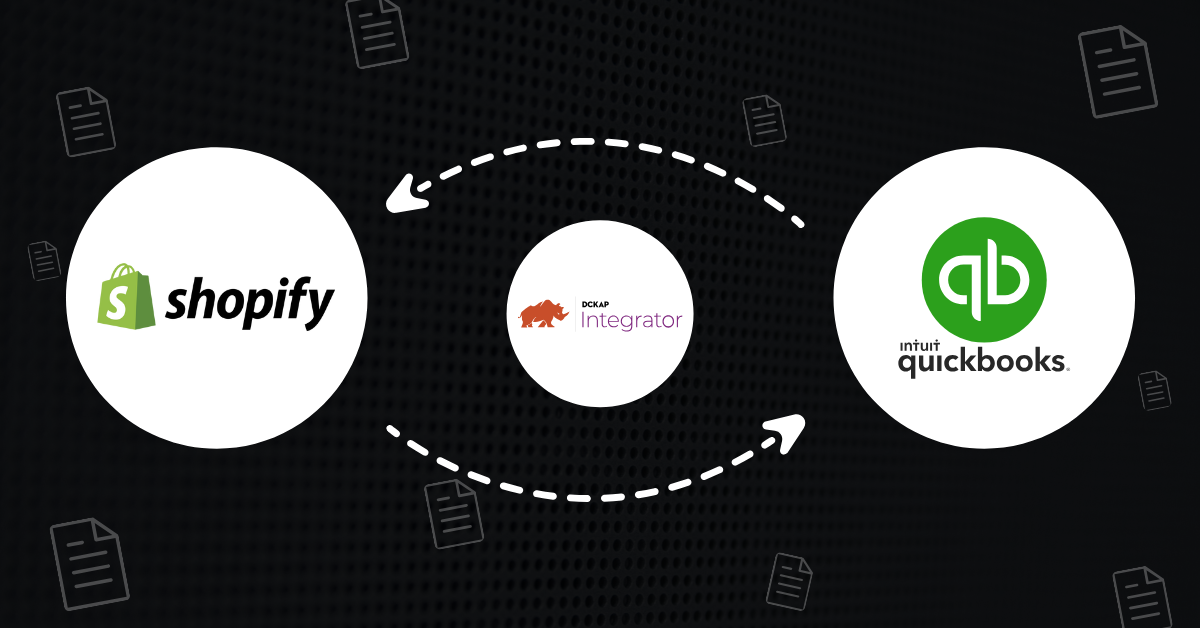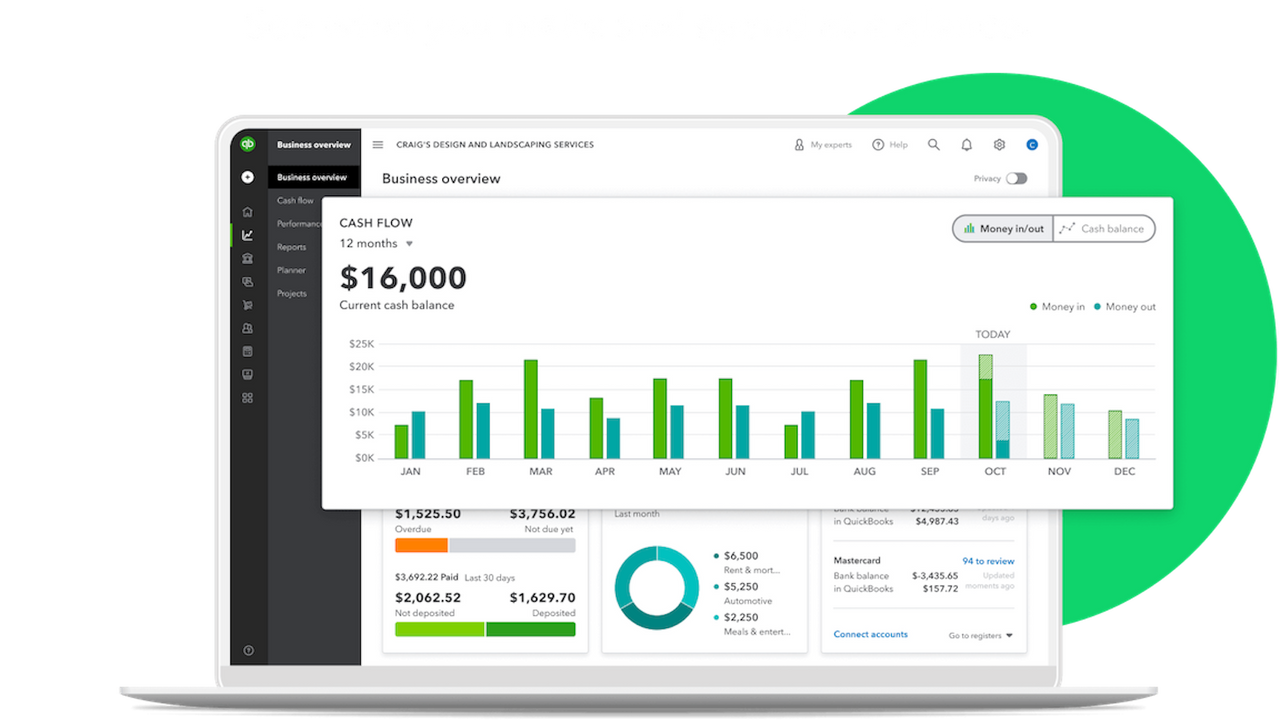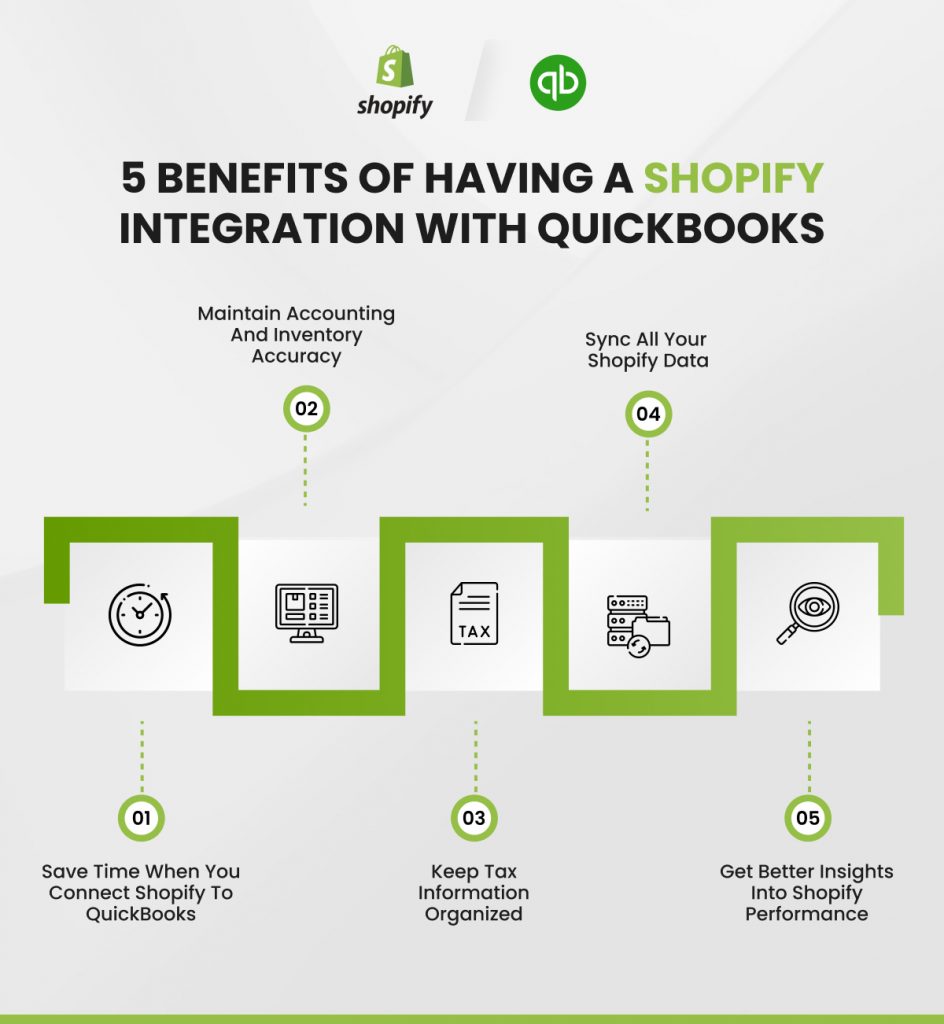Shopify integration with QuickBooks streamlines online business management. It connects e-commerce and accounting seamlessly.
This integration helps reduce manual data entry, saving time and effort. It also provides real-time insights into sales, expenses, and profits. Online store owners often face challenges when managing finances. Manually entering sales data into accounting software is time-consuming. Mistakes can occur.
Integration eliminates these issues. Shopify and QuickBooks together create a smooth workflow. Sales data syncs automatically. Inventory updates instantly. Financial reports are accurate and up-to-date. This integration empowers business owners to focus on growth. They can make informed decisions based on precise data. The combination of Shopify and QuickBooks offers a powerful tool for efficient business management.
Table of Contents
ToggleBenefits of Shopify Integration
Integrating Shopify with QuickBooks simplifies your e-commerce management. It helps automate accounting tasks, reducing manual data entry. This integration ensures accurate financial records, saving time and effort.
Integrating Shopify with QuickBooks offers a wealth of benefits that can transform how you manage your online store. The synergy between these platforms empowers you to streamline operations, making daily tasks more efficient and less prone to errors. Whether you’re juggling inventory or keeping your finances in check, the integration simplifies processes, saving you time and headaches. Have you ever wondered how much easier life could be with automated solutions? Let’s dive into the advantages you can leverage through this integration.
Simplifying Inventory Management
Imagine having an inventory system where everything is perfectly aligned. With Shopify and QuickBooks working together, you no longer have to manually update stock levels. The integration automatically syncs inventory data, reducing the risk of overselling or stockouts. You can easily track product availability and make informed decisions. Isn’t it comforting to know that your inventory is always up-to-date without lifting a finger?
Enhancing Financial Accuracy
Financial mishaps can be a nightmare for any business owner. Shopify’s integration with QuickBooks ensures that your sales data seamlessly flows into your accounting software. This reduces the chance of manual entry errors and provides accurate financial reports. You’ll have a clear view of your revenue, expenses, and profits. Have you ever had the peace of mind knowing your financials are precise and ready for tax season? Now, you can focus on growing your business instead of worrying about accounting discrepancies. The integration between Shopify and QuickBooks is not just about convenience; it’s about setting up a robust system that supports your business growth. By simplifying inventory management and enhancing financial accuracy, you free up your time to focus on what truly matters—your customers and your products. How will you use this newfound efficiency to elevate your business?

Credit: www.dckap.com
Getting Started With Integration
Integrating Shopify with QuickBooks streamlines your business operations. It merges e-commerce with accounting, enhancing efficiency and accuracy. This integration helps in tracking sales, managing inventory, and simplifying bookkeeping. Begin with a step-by-step guide to set up and prepare both platforms.
Setting Up Shopify
Start by logging into your Shopify account. Navigate to the admin panel. Find the ‘Apps’ section and click on it. Search for QuickBooks in the search bar. Select the QuickBooks app and click ‘Add app’. Follow the on-screen instructions to complete the installation. Ensure your store details are accurate before proceeding.
Preparing Quickbooks
Access your QuickBooks account. Go to the ‘Apps’ tab. Locate Shopify in the app marketplace. Click ‘Get app now’ to add Shopify to QuickBooks. Input your Shopify credentials when prompted. Adjust your QuickBooks settings for sales and inventory tracking. Verify that your QuickBooks version supports Shopify integration. This preparation ensures seamless data synchronization.
Choosing The Right Integration Tools
Selecting effective integration tools simplifies Shopify and QuickBooks connections. Streamline business processes by choosing compatible software. Ensure seamless data flow for improved financial management.
Choosing the right integration tools for connecting Shopify with QuickBooks can be a game-changer for your business. The right tools can streamline your operations, save you time, and reduce the risk of errors. But with so many options available, how do you know which ones are worth your investment? Let’s dive into some practical tips to guide your selection process.
Exploring App Options
Start by examining the various apps that offer Shopify and QuickBooks integration. Shopify’s app store has a plethora of choices, each with unique features and benefits. Consider apps like QuickBooks Online by OneSaas or A2X for Shopify, both highly rated by users. Read reviews and ratings to get a sense of user satisfaction and common issues. It’s like choosing a new smartphone; you want something reliable that fits your specific needs. Don’t hesitate to reach out to other business owners for recommendations. Real-world experience can provide insights that you won’t find in product descriptions.
Evaluating Key Features
Once you have a list of potential apps, evaluate their key features. Focus on what matters most to your business operations. Does the app offer automatic syncing of sales and inventory? This can drastically reduce manual data entry. Look for features like customizable reporting or multi-currency support if you sell internationally. These can be critical for accurate financial management. Consider the ease of use. A user-friendly interface can save you time during setup and daily operations. Remember the frustration of using a complicated tool? That’s what you want to avoid. Think about customer support options. If you encounter issues, having access to a responsive support team can make all the difference. Choosing the right integration tools can enhance your efficiency and accuracy. What features are non-negotiable for your business? Take the time to explore and evaluate, and you’ll find an integration solution that aligns perfectly with your needs.
Integration Process Steps
Streamline your business by connecting Shopify with QuickBooks. Sync sales data, manage inventory, and simplify accounting tasks effortlessly. This integration helps maintain accurate financial records and boosts operational efficiency.
Integrating Shopify with QuickBooks can significantly streamline your business operations by ensuring your sales and financial data are always in sync. This process might seem daunting at first, but breaking it down into manageable steps can make it much easier. Let’s explore the key steps to seamlessly connect these two powerful platforms.
Connecting Shopify and Quickbooks
Start by logging into your Shopify account and navigating to the App Store. Search for the QuickBooks Online app, and click to install it. You will need to grant permissions for QuickBooks to access your Shopify data—this step ensures that your sales, refunds, and customer details can be automatically synced. Once the app is installed, you’ll be prompted to log in to your QuickBooks account. This connection allows your Shopify sales data to transfer directly into QuickBooks, helping you keep track of your financials with minimal effort. Think about all the time you’ll save without having to manually input each sale! ###
Configuring Data Sync
After connecting, it’s crucial to configure how your data will sync between Shopify and QuickBooks. Decide which data points are most important for your business. Common options include syncing products, inventory levels, and customer information. You can customize the frequency of data sync—whether you prefer real-time updates, daily summaries, or another schedule that suits your business needs. This customization ensures that your financial records are always accurate and up-to-date. Imagine having a customer purchase something online, and without lifting a finger, your inventory and accounts update automatically. How would that transform your day-to-day operations? Taking the time to set up this configuration pays off in efficiency and accuracy. Remember, while technology can automate many processes, it’s always wise to double-check the initial setup. Ensure everything is syncing as expected to avoid any headaches down the line. A few minutes of verification can prevent hours of troubleshooting later. Have you ever thought about how this integration could affect your business growth? By freeing up time from administrative tasks, you can focus more on strategic initiatives and customer engagement.
Common Challenges And Solutions
Integrating Shopify with QuickBooks often presents challenges like data syncing and inventory management. Solutions include using third-party apps for seamless data flow and regular updates to prevent discrepancies.
Integrating Shopify with Quickbooks can streamline your business operations, but it’s not without its hurdles. You might find yourself asking: “Why does this integration seem so challenging?” Don’t worry; you’re not alone. Many users face common challenges that can disrupt their workflow. Let’s dive into these obstacles and explore practical solutions.
Troubleshooting Connection Issues
Establishing a reliable connection between Shopify and Quickbooks can sometimes feel like trying to solve a puzzle. You may encounter connection failures or delays that leave you frustrated. First, ensure both platforms are updated to their latest versions. Outdated software can often be the root of connectivity issues. Check your internet connection. A stable connection is crucial for seamless integration. If your connection is spotty, consider using a wired connection or moving closer to your router. Have you ever considered clearing your cache? This simple action can often resolve minor bugs that hinder connectivity. If these steps don’t work, reach out to customer support. They can provide insights specific to your setup.
Resolving Data Discrepancies
Data discrepancies between Shopify and Quickbooks can lead to inaccurate financial reporting. Such issues can affect your decision-making and business strategy. Begin by regularly reviewing your data entries. Ensure that product SKUs, prices, and descriptions match in both platforms. Inconsistent data entry is a common culprit of discrepancies. You might find it helpful to use automated data synchronization tools. These tools can minimize human error and keep your data consistent across platforms. Consider setting up a regular audit schedule. Periodically check both systems to identify and correct discrepancies before they become problematic. Have you ever thought about involving your team in this process? A fresh pair of eyes can catch errors that you might overlook. By addressing these challenges head-on, you can maintain a smooth workflow and keep your business running efficiently. What other solutions have you discovered in your integration journey?

Credit: apps.shopify.com
Optimizing Business Operations
Shopify integration with QuickBooks can transform business operations. This powerful combination simplifies tasks and improves customer satisfaction. Businesses thrive with streamlined processes and better service. Discover how automation and enhanced experiences can boost success.
Automating Routine Tasks
Automation saves time and reduces errors. Shopify and QuickBooks automate invoicing and inventory updates. Businesses can focus on growth rather than manual tasks. QuickBooks handles accounting, while Shopify manages sales data. This synergy enhances productivity.
Improving Customer Experience
Efficient systems lead to happier customers. QuickBooks and Shopify ensure accurate order processing and tracking. Customers enjoy timely delivery and accurate billing. Shopify integration with QuickBooks provides seamless shopping experiences. Happy customers return and refer others.
Monitoring And Maintenance
Ensure smooth operations by regularly monitoring Shopify and QuickBooks integration. Address any errors promptly for seamless financial management. Regular maintenance helps in keeping data synchronized and accurate.
Integrating Shopify with QuickBooks is a powerful way to streamline your e-commerce operations. However, the setup is just the beginning. Monitoring and maintaining the integration are crucial to ensure everything runs smoothly. Imagine this: You wake up to find your sales numbers are off because of a data sync issue. That’s a headache you can avoid with regular checks and updates. Here’s how you can keep your integration healthy and robust.
Regular Data Audits
Regular data audits are essential. They help you catch discrepancies early. You might notice mismatches between sales reports and financial records. Set a schedule for these audits, perhaps weekly or monthly. This routine will keep your data accurate and reliable. Tools within QuickBooks can assist in tracking these audits, ensuring efficiency.
Updating Integration Settings
Updating integration settings is another key aspect. Software updates may change how Shopify and QuickBooks interact. It’s your job to adjust settings accordingly. Keep an eye on notifications from both platforms. They often alert you to necessary updates. Being proactive prevents issues before they arise, saving you time and stress. What happens when you ignore updates? You risk losing vital functionality. Don’t let outdated settings hold your business back. Stay on top of updates to keep your operation running smoothly. Have you ever faced issues due to neglected updates? Share your experiences. It’s a great way to learn from each other and improve collectively. By focusing on monitoring and maintenance, you make sure your Shopify and QuickBooks integration remains a valuable asset, not a liability.
Future Trends In E-commerce Integration
The future of e-commerce integration is rapidly evolving. Businesses seek streamlined solutions to manage operations efficiently. Shopify integration with QuickBooks exemplifies this trend. It combines e-commerce capabilities with accounting power. This integration helps businesses save time and reduce errors.
Emerging Technologies
New technologies are shaping e-commerce integration. Artificial intelligence plays a key role. AI helps automate repetitive tasks. It improves data accuracy and speeds up processes. Machine learning analyzes consumer behavior. It offers insights for better decision-making. Cloud computing provides flexibility and scalability. It enables real-time data access from anywhere.
Impact on Small Businesses
Small businesses benefit greatly from e-commerce integration. It simplifies financial management. QuickBooks integration automates bookkeeping tasks. This saves time for small business owners. It helps them focus on growth strategies. Small businesses gain a competitive edge. They can offer seamless shopping experiences. This boosts customer satisfaction and loyalty.
Frequently Asked Questions
Does Shopify Integrate with Quickbooks?
Yes, Shopify integrates with QuickBooks. This connection simplifies accounting by automatically syncing sales data. Manage inventory, track expenses, and generate reports seamlessly. Enhance business efficiency with streamlined operations and improved financial insights.
Which Accounting Software Integrates With Shopify?
QuickBooks, Xero, and FreshBooks integrate with Shopify for seamless accounting. These tools streamline financial management and invoicing. Additionally, Sage and Wave also offer integration with Shopify, enhancing your business’s accounting efficiency. Choose software based on your specific business needs and requirements for optimal results.
How Do I Import Products From Quickbooks To Shopify?
Integrate QuickBooks and Shopify using a third-party app like QuickBooks Connector. Follow the app’s instructions to import products. Ensure data mapping and synchronization are accurate. Regularly update product information to maintain consistency between platforms. This process helps streamline inventory management and sales tracking efficiently.
How Do I Record Shopify Payments In Quickbooks Online?
Integrate Shopify with QuickBooks using an app like “Shopify Connector. ” Import sales data and match payments manually. Regularly reconcile transactions for accuracy. Ensure Shopify fees are recorded separately for clear financial insights. Use QuickBooks support for detailed guidance if needed.
Conclusion
Integrating Shopify with QuickBooks simplifies managing sales and finances. It saves time and reduces errors in bookkeeping. Business owners gain better control over their financial health. This integration helps streamline workflow for smoother operations. It keeps business data organized and easily accessible.
It also supports growth by offering real-time insights. Entrepreneurs can focus more on growing their business. This tool enhances efficiency without complicated processes. Your business benefits from improved accuracy and productivity. Consider this integration for easier financial management. Make your business operations more seamless today.




